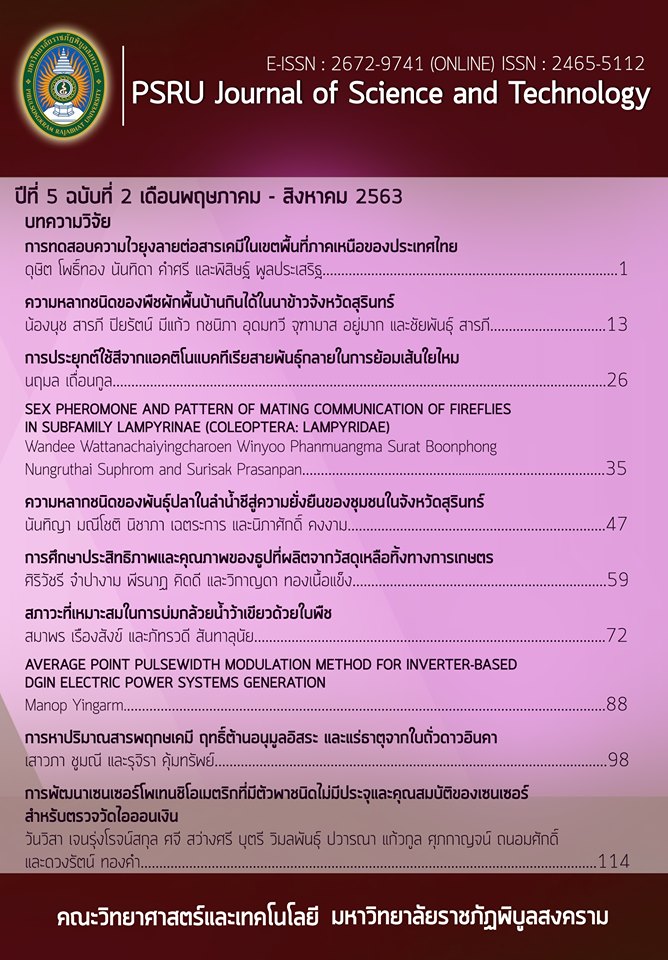DEVELOPMENT OF POTENTIOMETRIC SENSOR BASED ON NEUTRAL CARRIER AND THEIR PROPERTIES FOR SILVER ION DETECTION
Keywords:
Potentiometric sensor, PVC membrane, Silver ionAbstract
This research aimed to develop potentiometric sensor for silver ion detection based on neutral carrier L1 (chloro-8-[(pyridin-2-ylmethyl)-amino]-anthraquinone) in poly(vinyl chloride) (PVC) membrane plasticized with o-NPOE and KTpClPB was used as an ion exchanger. The results found that the best performance was observed for the membrane component of 0.35: 0.38: 33.08: 66.19 (L1: KTpClPB: PVC: o-NPOE, %w/w). It showed highly selective to silver ion with a complex formation constant (log bILn) between L1 and silver ion of 5.30±0.07. The polymeric membrane electrode exhibited near theoretical Nernstian slope of 59.50±0.3 mV decade-1 in a linear range from 1x10-5 to 1x10-2 mol L-1 with a limit of detection of 4.47x10-7 mol L-1. This electrode was used to measure the silver ion in a wide pH range of 4–8. Additionally, the fabricated electrode could be used as indicator electrode for potentiometric titration to determine chloride ion in vitamin B1 tablets compared to Mohr's method with no significant difference.
References
Ali, T.A., Mohamed, G.G., Eldessouky, H. & Adeeb, A-El. (2019). Ion selective electrodes based on methyl 6-(hydroxymethyl) picolinate ionophore for electrochemical determination of Fe (III) in petroleum water samples. Egyptian Journal of Petroleum, 28, 233–239.
de-los., M., Pérez, A.A., Marín, L.P., Quintana, J.C. & Yazdani-Pedram, M. (2003). Influence of different plasticizers on the response of chemical sensors based on polymeric membranes for nitrate ion determination. Sensors and Actuators B: Chemical, 89, 262–268.
de Namor, A.F.D., Gamouz, A.El., Alharthi, S., Hakawati, N.Al. & Varcoe, J.R. (2015). A ditopic calix[4]pyrrole amide derivative: highlighting the importance of fundamental studies and the use of NaPh4B as additive in the design and applications of mercury(II) ion selective electrodes. Journal of Materials Chemistry A, 3, 13016–13030.
Environmental Protection Agency (EPA). (1989). EPA Drinking Water Criteria Document for Silver (EPA CASRN 7440-7422-7444). USA.: Washington, D.C.
Eugster, E., Morf, P.M., Spichiger, U. & Simon, W. (1991). Selectivity-modifying Influence of Anionic Sites in Neutral Carrier-based Membrane Electrodes. Analytical Chemistry, 63, 2285–2289.
Furno, F., Morley, K.S., Wong, B., Sharp, B.L., Arnold, P.L., Howdle, S.M., Bayson, R., Brown, P.D., Winship, P.D. &
Reid, H.J. (2004). Silver nanoparticles and polymeric medical devices: a new approach to prevention of infection?. Journal of Antimicrobial Chemotherapy, 54, 1019–1024.
Hussaina, R., Khanb, M.Q. & Khan, A.A. (2019). Electrochemical sensing of Pb2+ ion in water by ion selective membrane electrode based on polypyrrole titanium(IV)sulphosalicylo phosphate cation exchange nanocomposite. Groundwater for Sustainable Development, 8, 216–225.
Janrungroatsakul, W., Vilaivan, T., Vilaivan, C., Watchasit, S., Suksai, C., Ngeontae, W., Aeungmaitrepirom, W., & Tuntulani, T. (2013). New calix[4]arene derivatives as ionophores in polymeric membrane electrodes for Ag(I): Comparative selectivity studies and detection of DNA hybridization. Talanta, 105, 1–7.
Janrungroatsakul, W., Thanasiwiwat, T., Thongkum., D. & Tuntulani, T. (2016). Fabrication of plasticized polymer membrane for silver ion selective electrode using anthraquinone derivative as an Ionophore. Burapha Science Journal, 21(2), 166–175. (in thai)
Khan, A.A., Khan, M.Q. & Hussain, R. (2018). Determination of Cu2+ in aqueous solution using a polyindole–tin (IV) molybdophosphate conductive nanocomposite ion-selective membrane electrode. Journal of Physics and Chemistry of Solids, 123, 113–123.
Meier, P.C. (1982). Two-parameter debye-hückel approximation for the evaluation of mean activity coefficients of 109 electrolytes. Analytica Chimica Acta, 136, 363–368.
Mi, Y. & Bakker, E. (1999). Determination of complex formation constants of lipophilic neutral ionophores in solvent polymeric membranes with segmented sandwich membranes. Analytical Chemistry, 71 5279–5287.
Moody, G.J., Oke, R. & Thomas, J.D.R. (1970). A calcium-sensitive electrode based on a liquid ion exchanger in
a poly (vinyl chloride) matrix. Analyst, 95, 910–918.
Ngeontae, W., Janrungroatsakul, W., Morakot, N., Aeungmaitrepirom, W. & Tuntulani. T. (2008). New silver selective electrode fabricated from benzothiazole calix[4]arene: speciation analysis of silver nanoparticles. Sensors and Actuators B: Chemical, 134, 377–385.
Poplawski, M.E., Brown, R.B., Rho, K.L., Yun, S.Y., Lee, H.J., Cha, G.S. & Phaeng, K.J. (1997). One-component room temperature vulcanizing-type silicone rubber-based sodium-selective membrane electrodes. Analytica Chimica Acta, 355, 249–257.
Rosatzin, T., Bakker, E., Suzuki, K. & Simon, W. (1993). Lipophilic and immobilized anionic additive in solvent polymeric Membranes of cation selective. Analytica Chimica Acta, 280, 197–203.
Reinhoud, D.N., Engebersen, J.F.J., Brzozka, Z., Van Der Vlekkert, H.H., Honing, G.W.N., Holterman, H.A.J. &
Verkerk, U.H. (1994). Development of durable K+-selective chemically modified field effect transistors with functionalized polysiloxane membranes. Analytical Chemistry, 66, 3618–3623.
Thongkum, D., Punaray, J., Sanguankul, W., Ratchakom, V. & Kumplong, P. (2015). Alkylamine anthraquinone chemical sensors to detect nickel and copper Ions. Srinakharinwirot Science Journal, 31(1), 51–64. (in thai)
Wygladacz, K., Radu, A., Xu, C., Qin, Y. & Bakker, E. (2005). Fiber-optic microsensor array based on fluorescent bulk optode microspheres for the trace analysis of silver ions. Analytical Chemistry, 77, 4706–4712.
Yun, S. Y., Hong, Y. K., Oh, B. K., Cha, G. S., Nam, H., Lee, S. B. & Jin, J.-II. (1997). Potentiometric properties of ion-selective electrode membranes based on segmented polyether urethane matrices. Analytical Chemistry, 69, 868–873.
Downloads
Published
How to Cite
Issue
Section
License
กองบรรณาธิการขอสงวนสิทธิ์ในการปรับปรุงแก้ไขตัวอักษรและคำสะกดต่างๆ ที่ไม่ถูกต้อง และต้นฉบับที่ได้รับการตีพิมพ์ในวารสาร PSRU Journal of Science and Technology ถือเป็นกรรมสิทธิ์ของคณะวิทยาศาสตร์และเทคโนโลยี มหาวิทยาลัยราชภัฏพิบูลสงคราม และ
ผลการพิจารณาคัดเลือกบทความตีพิมพ์ในวารสารให้ถือมติของกองบรรณาธิการเป็นที่สิ้นสุด







